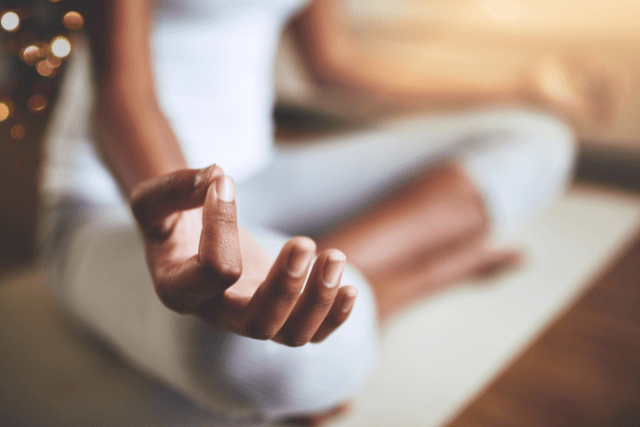Are you tired of feeling overwhelmed and anxious? Imagine a world where you can find peace and calm amidst the chaos of everyday life. Well, the good news is that you can achieve that with mindfulness meditation.
In this guide, we will explore the benefits of mindfulness for anxiety and provide you with practical tips on how to incorporate mindfulness into your daily routine.
So, if you’re ready to take control of your anxiety and experience a greater sense of inner peace, keep reading to discover the transformative power of mindfulness meditation.
Key Takeaways
- Mindfulness meditation has numerous benefits for mental, emotional, and physical well-being.
- Creating a peaceful and relaxing meditation space can enhance the meditation experience.
- There are various meditation techniques to explore, and it’s important to find the one that resonates with you.
- Breathing and focusing techniques are effective tools for practising mindfulness meditation.
Understanding Mindfulness Meditation
To truly grasp the concept of mindfulness meditation, it is essential to understand its core principles and how they can be applied to your everyday life. Mindfulness meditation is a practice that offers numerous benefits for your mental, emotional, and physical well-being.
One of the key benefits of mindfulness meditation is its ability to help you become more aware of your thoughts, feelings, and bodily sensations. By focusing on your breath, you can anchor yourself in the present moment and observe any distractions that may arise without judgment. This practice allows you to create greater clarity and understanding about your inner experiences.
When distractions arise during your meditation practice, it is important to acknowledge them without getting caught up in them. Instead of trying to push away or suppress distractions, observe them and gently bring your attention back to your breath.
Returning your focus to the breath helps strengthen your ability to stay present and focused in everyday life, even when faced with external distractions.
Benefits of Mindfulness for Anxiety
Mindfulness meditation can be a valuable tool for managing anxiety, offering a range of benefits that can help alleviate symptoms and promote a sense of calm and well-being. When it comes to coping with anxiety, incorporating mindfulness exercises into your daily routine can make a significant difference.
- Stress reduction: Mindfulness meditation helps you become more aware of your thoughts and feelings in the present moment, allowing you to manage better and reduce stress.
- Mind-body connection: By practising mindfulness, you can better understand the connection between your mind and body. This awareness can help you identify and address the physical sensations associated with anxiety.
- Calming techniques: Mindfulness meditation provides you with a toolkit of calming techniques that can be used whenever anxiety arises. These techniques, such as deep breathing and body scanning, can help you relax and find peace.
Setting Up Your Meditation Space
Creating a dedicated space for your mindfulness meditation practice can enhance your overall experience and provide a supportive environment for your journey towards inner peace and well-being.
When setting up your meditation space, creating an ambience that promotes relaxation and tranquillity is important. Choose materials that are calming and soothing to the senses, such as soft fabrics, natural fibres, and warm colours. Consider incorporating essential oils, like lavender or chamomile, to enhance the atmosphere and promote a sense of calmness.
Natural lighting can also play a significant role in creating a peaceful meditation space. Choose a room with ample natural light whenever possible, or use soft, diffused lighting to create a serene environment. It is important to avoid harsh or bright lights that can distract or disrupt your focus.
Additionally, having a comfortable and supportive meditation cushion can greatly enhance your practice. Choose a cushion that suits your body type and allows you to sit comfortably for extended periods.
Experiment with different cushion styles and materials to find the one that best supports your body and allows you to maintain a relaxed and upright posture.
Finding the Right Meditation Technique
Once you have set up your meditation space to create a peaceful and supportive environment, the next step is to find the right meditation technique for your mindfulness practice. Choosing a technique that resonates with you is essential for cultivating a deep and meaningful meditation practice.
- Explore different methods: There are various meditation techniques available, such as breath awareness, loving-kindness meditation, body scan, and walking meditation. Explore these different methods and see which one resonates with you the most. Trust your intuition and choose the technique that feels right for you.
- Try different approaches: Each meditation technique may have different approaches or variations. For example, if you choose breath awareness, you can experiment with focusing on the sensations of the breath at the nostrils or the rising and falling of the abdomen. Trying different approaches can help you find the one that suits your needs and preferences.
- Experiment with styles: Different meditation styles, such as Zen, Vipassana, or Transcendental Meditation, offer unique approaches to mindfulness. Explore these styles and see if any resonate with you. Each style has its philosophy and techniques, so experimenting with different styles can broaden your understanding of meditation.

Breathing Techniques for Mindful Meditation
Incorporating specific breathing techniques can be incredibly beneficial to cultivate a sense of calm and focus during your mindfulness meditation practice. Deep breathing, also known as diaphragmatic breathing, is a technique that involves taking slow, deep breaths, filling your lungs, and exhaling fully. This type of breathing helps activate the body’s relaxation response, reducing stress and anxiety.
Another effective breathing technique is box breathing, which involves inhaling slowly for a count of four, holding the breath for a count of four, exhaling slowly for a count of four, and then pausing for a count of four before starting again. This technique helps regulate your breath and bring balance and stability to your meditation practice.
Alternate nostril breathing is a technique that involves breathing in through one nostril, closing it off with your finger, and then exhaling through the other nostril. This technique helps balance the energy in your body and promotes a sense of calm and focus.
In addition to these specific breathing techniques, incorporating relaxation techniques such as progressive muscle relaxation or guided imagery can further enhance your mindfulness meditation practice. These techniques help release tension in the body and calm the mind, allowing you to experience a deeper state of relaxation and presence.
Focusing Techniques for Mindful Meditation
When practising mindful meditation, it is important to develop effective focusing techniques to help calm your mind and bring a deeper sense of presence to your practice. Here are some techniques that can assist you in maintaining your focus:
- Mindful Breathing: Focus on your breath, observing each inhalation and exhalation. Use your breath as an anchor to bring your mind back to the moment whenever it wanders.
- Body Scan: Take a few moments to scan your body from head to toe, noticing any sensations or areas of tension. This technique helps you cultivate awareness of your physical state and brings you into the present moment.
- Walking Meditation: Engage in walking meditation by paying attention to each step. Feel the sensation of your feet touching the ground and tune into the movement of your body. This practice can help you integrate mindfulness into your daily activities.
Dealing With Distractions During Meditation
Dealing with distractions can sometimes be tough, but there are simple tricks to help stay focused. First, find a quiet spot to work. It could be a specific table or a corner in your room. Next, figure out what tasks are most important and do them first.
This way, even if distractions pop up later, you’ve already finished the big stuff. Turn off notifications on your phone and computer to avoid being tempted. You can also use apps that block distracting websites. Let people around you know when you need to concentrate so they can give you some space.
Try taking short breaks between tasks to recharge. And don’t forget, it’s okay to change your strategies if something’s not working. You can beat distractions and get things done with a few simple steps! 🚀👍
Instead of getting frustrated or discouraged, view them as opportunities to strengthen your practice.

Establishing a Daily Meditation Routine
Establishing a daily meditation routine is a powerful way to cultivate mindfulness and bring greater peace and clarity. By dedicating a specific time each day to sit in meditation, you create a sacred space for self-reflection and self-care.
Here are a few tips to help you establish a daily meditation practice:
- Choose a consistent time: Find a time that works best for you, whether in the morning, during lunch break, or before bed. Consistency is key to building a habit.
- Create a meditation space: Designate a quiet and peaceful area in your home where you can meditate without distractions. Fill it with items that inspire tranquillity, such as candles, cushions, or plants.
- Experiment with different techniques: Explore various meditation techniques to find what resonates with you. Whether focusing on the breath, repeating a mantra, or visualizing peaceful imagery, find a technique that helps you cultivate mindfulness.
Incorporating Mindfulness Into Everyday Activities
To bring mindfulness into your everyday activities, it’s important to cultivate a sense of present-moment awareness. Mindfulness is not just about sitting in meditation; it’s about being fully present in whatever you are doing. By incorporating mindfulness into your daily routine, you can bring a sense of calm and clarity to even the most mundane tasks.
One way to practice mindfulness is through mindful eating. Instead of rushing through meals or eating on the go, take the time to savour each bite. Pay attention to the flavours, textures, and sensations in your mouth. By eating mindfully, you can better tune into your body’s hunger and fullness cues.
Another activity that lends itself well to mindfulness is walking. Whether walking in nature or simply from one room to another, bring your attention to each step. Notice the feeling of your feet touching the ground, the movement of your body, and the sights and sounds around you.
| Mindful Eating | Mindful Walking |
|---|---|
| Pay attention to flavours, textures, and sensations | Notice each step |
| Pay attention to flavors, textures, and sensations | Observe the feeling of feet on the ground |
| Tune into your body’s hunger and fullness cues | Be aware of the movement of your body |
| Eat slowly and without distractions | Take in the sights and sounds around you |
Mindful commuting is another opportunity to practice mindfulness. Instead of getting caught up in traffic or rushing to your destination, use the time to focus on your breath and bring your attention to the present moment. Notice the sensations of sitting in the car or on public transportation, and let go of any tension or stress.
You can also incorporate mindfulness into your daily self-care routine. Whether you are taking a bath or shower, use this time to be fully present and aware of the sensations on your skin, the smell of the soap, and the feeling of the water. By bringing mindfulness to these activities, you can turn them into moments of relaxation and rejuvenation.
Lastly, even cleaning can become a mindful practice. Instead of rushing through chores, bring your attention to the task. Notice the movements of your body, the sensations of cleaning, and the satisfaction of a job well done. By approaching cleaning with mindfulness, you can turn it into meditation.
Tips for Maintaining Consistency in Your Practice
As you continue to incorporate mindfulness into your everyday activities, finding ways to maintain consistency in your practice is important. Consistency is key to reaping the full benefits of mindfulness meditation and experiencing true liberation from anxiety.
- Maintaining motivation: Remind yourself why you started practising mindfulness in the first place. Reflect on how it has positively impacted your life, and remember those motivations.
- Overcoming obstacles: Recognize that obstacles are a natural part of any journey. When faced with challenges, approach them with compassion and curiosity. Use them as opportunities for growth and learning rather than reasons to give up.
- Building a support system: Surround yourself with like-minded individuals who understand the value of mindfulness. Seek meditation groups or online communities where you can share your experiences and gain support from others on this path.
Remember to track your progress along the way. Keep a journal to document any shifts or insights you experience during your mindfulness practice. This will not only help you stay accountable but also serve as a reminder of how far you’ve come.
Conclusion
Incorporating mindfulness meditation into your daily routine can be a powerful tool for reducing anxiety. By creating a dedicated meditation space, finding the right technique, and practising breathing exercises, you can cultivate a sense of calm and focus.
Remember to be patient with yourself and embrace any distractions that may arise during your practice. With consistency and mindfulness in everyday activities, you can make a positive impact on your overall well-being. Keep up the practice and enjoy the benefits it brings.














Leave a Reply